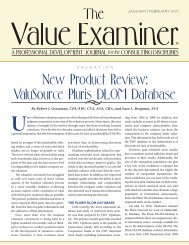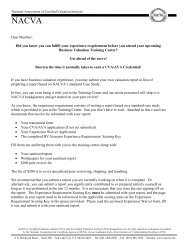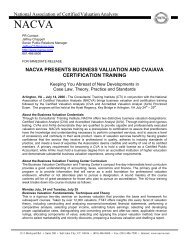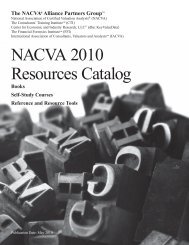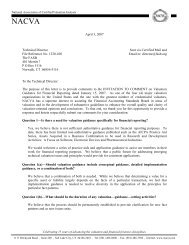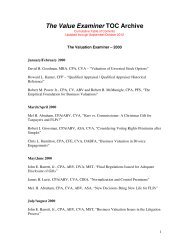VALUATION DISCOUNTS AND PREMIUMS
VALUATION DISCOUNTS AND PREMIUMS
VALUATION DISCOUNTS AND PREMIUMS
Create successful ePaper yourself
Turn your PDF publications into a flip-book with our unique Google optimized e-Paper software.
<strong>VALUATION</strong> <strong>DISCOUNTS</strong> <strong>AND</strong> <strong>PREMIUMS</strong>Fundamentals, Techniques & Theoryi) Hall & Polacek Study (1994)(1) Restricted stock study(2) Analyzed Tax Court decisions from 1981-1993 in an attempt to read thechanging pulse of the Tax Court with respect to discounts for minority interestand lack of marketability(3) Analyzed the results of a study performed by FMV Opinions, Inc.(a) Examined over 100 restricted stock transactions from 1979 through April1982(b) Regarded as an update to the Institutional Investor Study Report of the SEC(c) Corroborated the conclusions of the SEC Study–the size of the discount isoften a function of the size of the subject company’s revenues, earnings andthe exchange on which the restricted stock was traded(d) Mean discount of 23 percent was very similar to overall mean discounts of25.8 percent from the SEC Study(e) Highlighted three additional variables as influencing the size of discount forlack of marketability:i) Market value or capitalization of the issuing companyii) Dollar value of the block of stockiii) Percentage size of the block of stock being sold(f) Also analyzed the temperament of the Tax Court with respect to the use ofempirical studies:j) Johnson Study (1999)i) Referenced the Moore Study (“Valuation Revisited,” 126 Trusts &Estates 40, Feb, 1987) which observed that between 1985 and 1992, thediscounts for lack of marketability ranged between 10-36 percent, witha mean discount of 21 percent—a decline from the levels of prior yearsii) A review of these cases by the authors suggests that:“Taxpayers who failed to present any empirical data orreasoning as to why a certain discount should be grantedwere generally awarded low discounts. Similarly, where theService’s expert presented convincing reasons why a lowdiscount was appropriate, the lack of rebuttal evidence by thetaxpayer caused the court to accept the Service’s argument inits entirety.”… High discounts will be allowed in appropriatecases but will be disallowed absent convincing proof by thetaxpayer.”The Bruce Johnson study included 72 restricted stock studies from 1991 to 1995 withan average discount of 20.2%. Johnson’s study concluded that companies with thehighest level of earnings had an average discount of 6.3%. Additionally, those with atransaction size of $25 million or greater had an average discount of 10.8%. Therange of discount in this study was -10% to 60% with a standard deviation of 16%.The average discount for lack of marketability was less than the earlier studies due24 – Chapter Seven © 1995–2011 by National Association of Certified Valuators and Analysts (NACVA). All rights reserved.2012.v1 Used by Institute of Business Appraisers with permission of NACVA for limited purpose of collaborative training.



